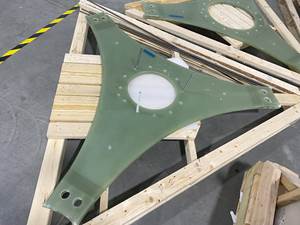San Diego activates largest seawater desalination plant in US
Composite pressure vessels are a critical component of a new $1 billion seawater desalination facility that will supply fresh water to 400,000 people in San Diego County, CA, US.
The Carlsbad Desalination Project (Carlsbad, CA, US) reports that operations are now under way at the nation’s largest and most technologically advanced seawater desalination plant. After successfully completing construction, the Carlsbad Desalination Plant—dedicated to Carlsbad’s former Mayor Claude “Bud” Lewis—has already produced more than 1.5 billion gallons of locally controlled water for San Diego County (CA, US), helping to minimize the region’s vulnerability to the statewide drought.
As reported in ÂÌñÏ×ÆÞ February 2014 story, "Designing pressure vessels for seawater desalination plants," Protec-Arisawa America in Vista, Calif. produced 2236 pressure vessels—filament wound to ASME Code Section X safety standard—for the SeaWater Reverse Osmosis (SWRO) desalination system used by the Carlsbad plant. (Also see CW, February 2013: "Composites slake the world’s thirst.")
The Carlsbad Desalination Plant is the result of a 30-year water purchase agreement between the plant’s developer and owner, Poseidon Water, and the San Diego County Water Authority for the production of up to 56,000 acre-feet of water per year, enough to meet the needs of approximately 400,000 people. It is a major component of the Water Authority’s multi-decade strategy to diversify the region’s water supply portfolio.
California Assembly Speaker Toni Atkins, attending the opening, said, “The Poseidon project not only provides San Diego County with a drought-proof water supply, it also demonstrates how California can meet the water needs of future generations.”
The $1 billion desalination project includes three main components: the desalination plant adjacent to NRG Energy’s Encina Power Station on Agua Hedionda Lagoon; a 10-mile pipeline that connects to the Water Authority’s regional distribution system; and upgrades to Water Authority facilities for distributing desalinated seawater throughout the region. The plant provides a highly reliable water supply produced with state-of-the-art technology to reduce energy demands, and it will be the first water infrastructure project in the state to have a zero net carbon footprint.
The Carlsbad plant uses reverse osmosis to produce approximately 10% of the region’s water supply; it is a core supply regardless of weather conditions, and it is blended with water from other sources for regional distribution. It costs less than 0.5 cents to produce a gallon of drinking water at the plant. Desalinated water will cost typical homeowners in the region about an additional $5 per month, in line with the low end of projections when the project was launched in late 2012. The costs are already factored into the Water Authority’s 2016 rates.
Mark Weston, chair of the San Diego County Water Authority’s Board of Directors also spoke: “The Claude ‘Bud’ Lewis Carlsbad Desalination Plant opens a new chapter in water supply reliability for the San Diego region and the state by tapping the potential of the Pacific Ocean and reducing dependence on strained resources such as the Sacramento-San Joaquin Bay-Delta. It is bolstering the San Diego region’s self-reliance, and in turn, its future.”
The Carlsbad Desalination Project included 1.5 million hours of work in Carlsbad, Vista and San Marcos, supporting an estimated 2,500 jobs and infusing $350 million into the local economy. Project partners included the Water Authority, Poseidon Water, IDE Technologies, Stonepeak Infrastructure Partners and Kiewit-Shea Desalination.
Poseidon Water is a private company that partners with public agencies to deliver water infrastructure projects. The company’s primary focus is developing large-scale reverse osmosis seawater desalination plants, and Poseidon is developing a second desalination facility in Huntington Beach, CA.
“This pioneering project is the result of more than 17 years of planning, permitting and construction,” said Poseidon Water CEO Carlos Riva. “It required teamwork between Poseidon Water, the Water Authority, our contractors, NRG Energy, and the cities of Carlsbad, Vista and San Marcos. Together, we are proud to provide a vital resource for the San Diego region.”
The plant will be operated by IDE Technologies, an international leader in water treatment solutions. NRG, a Fortune 200 energy company, is hosting the desalination plant as owner of the six-acre site where it sits.
After 30 years of operation at the Carlsbad plant, the Water Authority has the option – but not the obligation – to purchase the plant for $1. The agency also has the right to buy the facility after 10 years, though it isn’t required to do so.
Related Content
Composites end markets: Energy (2024)
Composites are used widely in oil/gas, wind and other renewable energy applications. Despite market challenges, growth potential and innovation for composites continue.
Read MoreRevolutionizing space composites: A new era of satellite materials
A new approach for high volumes of small satellite structures uses low-CTE, low-cost CFRP cellular core, robust single-ply skins and modular panel systems to cut lead time, labor and cost for reflectors, solar arrays and more.
Read MoreSRI develops scalable, infiltration-free ceramic matrix composites
Work in two DOE projects is demonstrating C/C-SiC produced in 3-5 days with <5% shrinkage, <10% porosity and 50% the cost of conventional C/C and C/C-SiC.
Read MoreRTM, dry braided fabric enable faster, cost-effective manufacture for hydrokinetic turbine components
Switching from prepreg to RTM led to significant time and cost savings for the manufacture of fiberglass struts and complex carbon fiber composite foils that power ORPC’s RivGen systems.
Read MoreRead Next
Cutting 100 pounds, certification time for the X-59 nose cone
Swift Engineering used HyperX software to remove 100 pounds from 38-foot graphite/epoxy cored nose cone for X-59 supersonic aircraft.
Read MoreCeramic matrix composites: Faster, cheaper, higher temperature
New players proliferate, increasing CMC materials and manufacturing capacity, novel processes and automation to meet demand for higher part volumes and performance.
Read MoreScaling up, optimizing the flax fiber composite camper
Greenlander’s Sherpa RV cab, which is largely constructed from flax fiber/bio-epoxy sandwich panels, nears commercial production readiness and next-generation scale-up.
Read More











